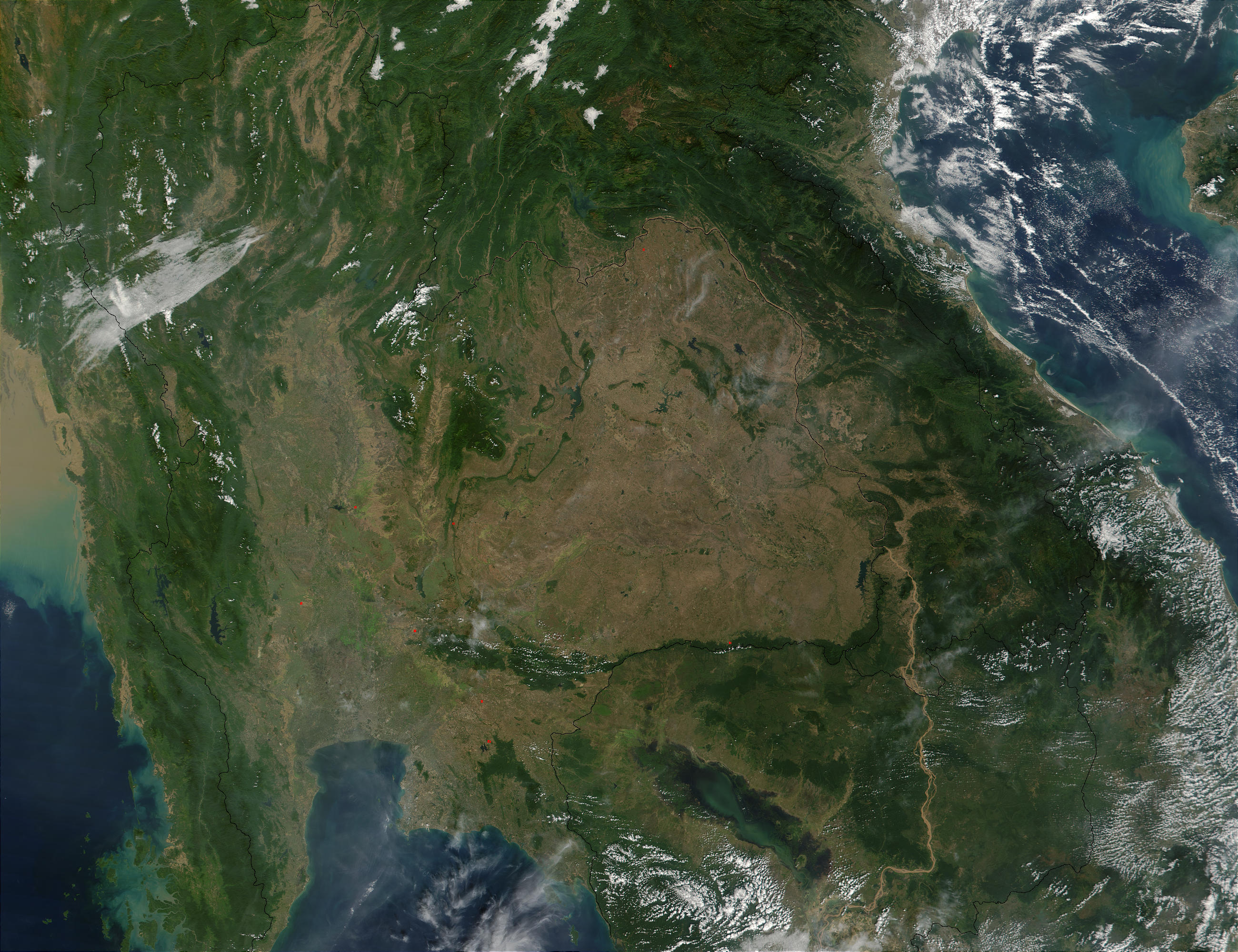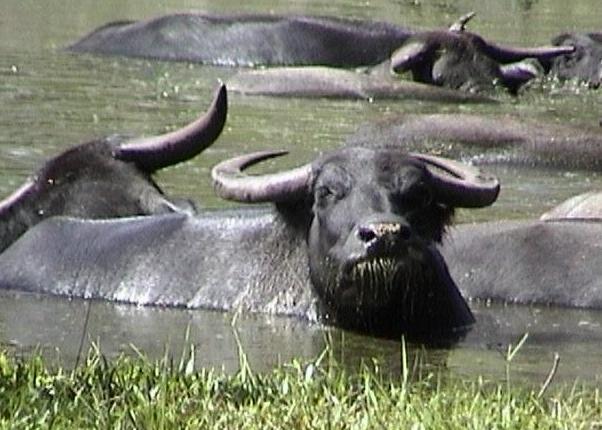|
Agriculture In Laos
The southeast Asian country of Laos, with a landmass of 23.68 million hectares, has at least 5 million hectares of land suitable for cultivation (about 21 percent). Seventeen percent of this land area (between 850,000 and 900,000 hectares) is actually cultivated, less than 4 percent of the total area. Rice accounted for about 80 percent of cultivated land during the 1989-90 growing season, including 422,000 hectares of lowland wet rice and 223,000 hectares of upland rice. This demonstrates that although there is interplanting of upland crops and fish are found in fields, irrigated rice agriculture remains basically a monoculture system despite government efforts to encourage crop diversification. Cultivated land area had increased by about 6 percent from 1975 to 1977 but in 1987 only provided citizens with less than one-fourth of a hectare each, given a population of approximately 3.72 million in 1986. In addition to land under cultivation, about 800,000 hectares ar ... [...More Info...] [...Related Items...] OR: [Wikipedia] [Google] [Baidu] |
Rice Planting Near Champasak (Laos)
Rice is a cereal grain and in its Domestication, domesticated form is the staple food of over half of the world's population, particularly in Asia and Africa. Rice is the seed of the grass species ''Oryza sativa'' (Asian rice)—or, much less commonly, ''Oryza glaberrima'' (African rice). Asian rice was domesticated in China some 13,500 to 8,200 years ago; African rice was domesticated in Africa about 3,000 years ago. Rice has become commonplace in many cultures worldwide; in 2023, 800 million tons were produced, placing it third after sugarcane and maize. Only some 8% of rice is traded internationally. China, India, and Indonesia are the largest consumers of rice. A substantial amount of the rice produced in developing nations is lost after harvest through factors such as poor transport and storage. Rice yields can be reduced by pests including insects, rodents, and birds, as well as by weeds, and by List of rice diseases, diseases such as rice blast. Traditional rice polyc ... [...More Info...] [...Related Items...] OR: [Wikipedia] [Google] [Baidu] |
Animal Husbandry
Animal husbandry is the branch of agriculture concerned with animals that are raised for meat, animal fiber, fibre, milk, or other products. It includes day-to-day care, management, production, nutrition, selective breeding, and the raising of livestock. Husbandry has a long history, starting with the Neolithic Revolution when animals were first Domestication, domesticated, from around 13,000 BC onwards, predating farming of the History of agriculture, first crops. During the period of ancient societies like ancient Egypt, cattle, sheep, goats, and pigs were being raised on farms. Major changes took place in the Columbian exchange, when Old World livestock were brought to the New World, and then in the British Agricultural Revolution of the 18th century, when livestock breeds like the English Longhorn, Dishley Longhorn cattle and Lincoln (sheep), Lincoln Longwool sheep were rapidly improved by agriculturalists, such as Robert Bakewell (agriculturalist), Robert Bakewell, to yi ... [...More Info...] [...Related Items...] OR: [Wikipedia] [Google] [Baidu] |
Bolikhamxai
Bolikhamsai (, ), formerly gallicized as Borikhamxay, is a province of Laos. Pakxan, Thaphabat, Pakkading, Borikhane, Viengthong, and Khamkeut are its districts and Pakxan is its capital city. The province is the site of the Nam Theun 2 Dam, the country's largest hydroelectric project. It covers an area of . History The province faced invasions from the Siamese throughout its history. The foundation of Paksan dates from the late nineteenth century. In 1836, the Siamese assumed suzerainty over Laos. The province was formed in 1986 from parts of the Vientiane province and Khammuan. In February 2005, 100 villagers were forced to sell their possessions and prepare to be evicted in Kok Poh village in Borikham District, and the central authorities intervened to stop this. Geography Bolikhamsai province covers an area of . It borders Xiangkhouang province to the northwest, Vietnam to the east, Khammouane province to the south, and Thailand to the west. Settlements include P ... [...More Info...] [...Related Items...] OR: [Wikipedia] [Google] [Baidu] |
Vientiane
Vientiane (, ) is the capital city, capital and largest city of Laos. Situated on the banks of the Mekong, Mekong River at the Thailand, Thai border, it comprises the five urban districts of Vientiane Prefecture and had a population of 840,000 as of the 2023 Census. Established as the capital of the Kingdom of Lan Xang in 1563, Vientiane served as the administrative center during French rule and retains colonial-era architecture alongside Buddhist landmarks such as Pha That Luang, a national symbol of Buddhism in Laos, Buddhism, and Haw Phra Kaew, which once housed the Emerald Buddha until its 18th-century relocation to Thailand. Vientiane emerged as a significant settlement in the 16th century as part of the Lan Xang Kingdom. Over time, Vientiane developed into an important regional center, serving as the kingdom’s administrative and cultural hub. However, the city experienced periods of turmoil, including invasions by the Rattanakosin Kingdom (1782–1932), Siamese (Thai) k ... [...More Info...] [...Related Items...] OR: [Wikipedia] [Google] [Baidu] |
Mekong
The Mekong or Mekong River ( , ) is a transboundary river in East Asia and Southeast Asia. It is the world's twelfth-longest river and the third-longest in Asia with an estimated length of and a drainage area of , discharging of water annually. From its headwaters in the Tibetan Plateau, the river runs through Southwest China (where it is officially called the Lancang River), Myanmar, Laos, Thailand, Cambodia, and southern Vietnam. The extreme seasonal variations in flow and the presence of rapids and waterfalls in the Mekong make navigation difficult, though the river remains a major trade route between Tibet and Southeast Asia. The construction of hydroelectric dams along the Mekong in the 2000s through the 2020s has caused serious problems for the river's ecosystem, including the exacerbation of drought. Names The Mekong was originally called ''Mae Nam Khong'' from a contracted form of Kra-Dai shortened to ''Mae Khong''. In Thai and Lao, ''Mae Nam'' ("Mother ... [...More Info...] [...Related Items...] OR: [Wikipedia] [Google] [Baidu] |
Foreign Agricultural Service
The Foreign Agricultural Service (FAS) is the United States Foreign Service#Foreign affairs agencies, foreign affairs agency with primary responsibility for the United States Department of Agriculture's (USDA) overseas programs – market development, trade pact, international trade agreements and negotiations, and the collection of statistics and market information. It also administers the USDA's Export credit agency, export credit guarantee and food aid programs and helps increase income and food availability in developing nations by mobilizing expertise for agriculturally led economic growth. The FAS mission statement reads, "Linking U.S. agriculture to the world to enhance export opportunities and global food security," and its motto is "Linking U.S. Agriculture to the World." Early history USDA posted its first employee abroad in 1882, with assignment of Edmund Moffat to London. In 1894, USDA created a Section of Foreign Markets in its Division of Statistics, which by 1901 nu ... [...More Info...] [...Related Items...] OR: [Wikipedia] [Google] [Baidu] |
USDA
The United States Department of Agriculture (USDA) is an United States federal executive departments, executive department of the Federal government of the United States, United States federal government that aims to meet the needs of commercial farming and livestock food production, promotes agricultural trade and production, works to assure food safety, protects natural resources, fosters rural communities and works to end hunger in the United States and internationally. It is headed by the secretary of agriculture, who reports directly to the president of the United States and is a member of the president's Cabinet of the United States, Cabinet. The current secretary is Brooke Rollins, who has served since February 13, 2025. Approximately 71% of the USDA's $213 billion budget goes towards nutrition assistance programs administered by the Food and Nutrition Service (FNS). The largest component of the FNS budget is the Supplemental Nutrition Assistance Program (formerly ... [...More Info...] [...Related Items...] OR: [Wikipedia] [Google] [Baidu] |
Arable Land
Arable land (from the , "able to be ploughed") is any land capable of being ploughed and used to grow crops.''Oxford English Dictionary'', "arable, ''adj''. and ''n.''" Oxford University Press (Oxford), 2013. Alternatively, for the purposes of agricultural statistics, the term often has a more precise definition: A more concise definition appearing in the Eurostat glossary similarly refers to actual rather than potential uses: "land worked (ploughed or tilled) regularly, generally under a system of crop rotation". In Britain, arable land has traditionally been contrasted with pasturable land such as heaths, which could be used for sheep-rearing but not as farmland. Arable land is vulnerable to land degradation and some types of un-arable land can be enriched to create useful land. Climate change and biodiversity loss are driving pressure on arable land. By country According to the Food and Agriculture Organization of the United Nations, in 2013, the world's arable land amo ... [...More Info...] [...Related Items...] OR: [Wikipedia] [Google] [Baidu] |
A Group Of Women Plant Paddy Rice Seedlings In A Field Near Sekong (1)
A, or a, is the first letter and the first vowel letter of the Latin alphabet, used in the modern English alphabet, and others worldwide. Its name in English is '' a'' (pronounced ), plural ''aes''. It is similar in shape to the Ancient Greek letter alpha, from which it derives. The uppercase version consists of the two slanting sides of a triangle, crossed in the middle by a horizontal bar. The lowercase version is often written in one of two forms: the double-storey and single-storey . The latter is commonly used in handwriting and fonts based on it, especially fonts intended to be read by children, and is also found in italic type. In English, '' a'' is the indefinite article, with the alternative form ''an''. Name In English, the name of the letter is the ''long A'' sound, pronounced . Its name in most other languages matches the letter's pronunciation in open syllables. History The earliest known ancestor of A is ''aleph''—the first letter of the Phoenician ... [...More Info...] [...Related Items...] OR: [Wikipedia] [Google] [Baidu] |
Chicken
The chicken (''Gallus gallus domesticus'') is a domesticated subspecies of the red junglefowl (''Gallus gallus''), originally native to Southeast Asia. It was first domesticated around 8,000 years ago and is now one of the most common and widespread domesticated animals in the world. Chickens are primarily kept for chicken as food, their meat and egg as food, eggs, though they are also kept as pets. As of 2023, the global chicken population exceeds 26.5 billion, with more than 50 billion birds produced annually for consumption. Specialized breeds such as broilers and laying hens have been developed for meat and egg production, respectively. A hen bred for laying can produce over 300 eggs per year. Chickens are social animals with complex vocalizations and behaviors, and cultural references to chickens, feature prominently in folklore, religion, and literature across many societies. Their economic importance makes them a central component of global animal husbandry and agricu ... [...More Info...] [...Related Items...] OR: [Wikipedia] [Google] [Baidu] |
Water Buffalo
The water buffalo (''Bubalus bubalis''), also called domestic water buffalo, Asian water buffalo and Asiatic water buffalo, is a large bovid originating in the Indian subcontinent and Southeast Asia. Today, it is also kept in Italy, the Balkans, Australia, North America, South America and some African countries. Two extant Type (biology), types of water buffalo are recognized, based on Morphology (biology), morphological and Ethology, behavioural criteria: the river buffalo of the Indian subcontinent and further west to the Balkans, Egypt and Italy; and the swamp buffalo from Assam in the west through Southeast Asia to the Yangtze Valley of China in the east. The wild water buffalo (''Bubalus arnee'') is most probably the ancestor of the domestic water buffalo. Results of a phylogenetic study indicate that the river-type water buffalo probably originated in western India and was domesticated about 6,300 years ago, whereas the swamp-type originated independently from Mainland Sou ... [...More Info...] [...Related Items...] OR: [Wikipedia] [Google] [Baidu] |










